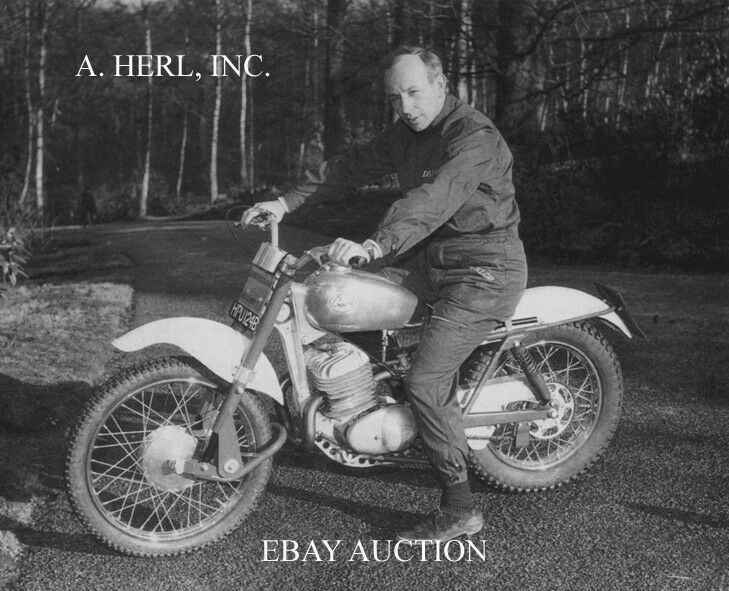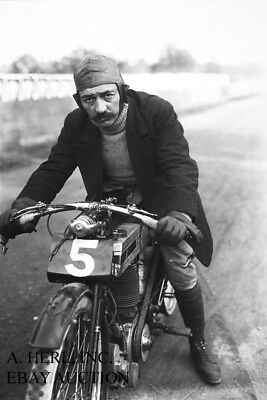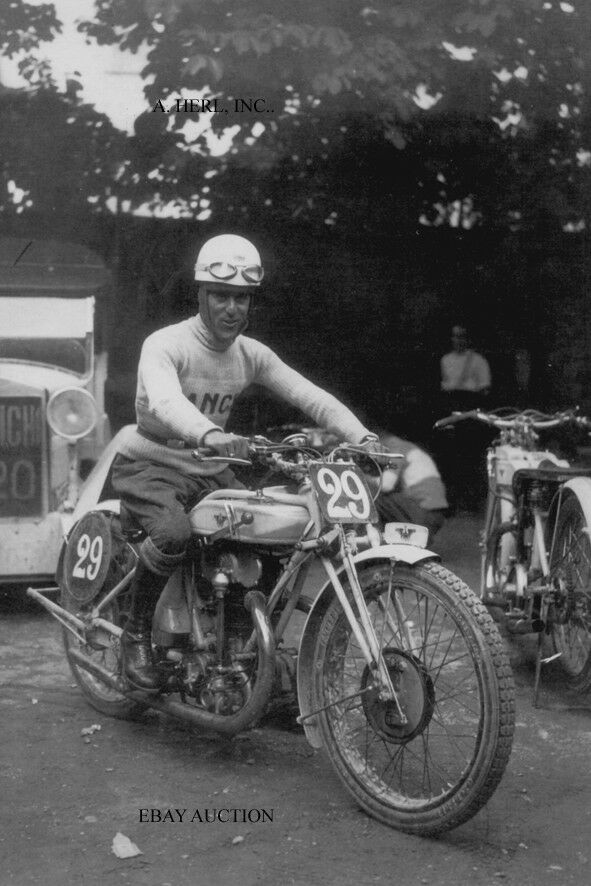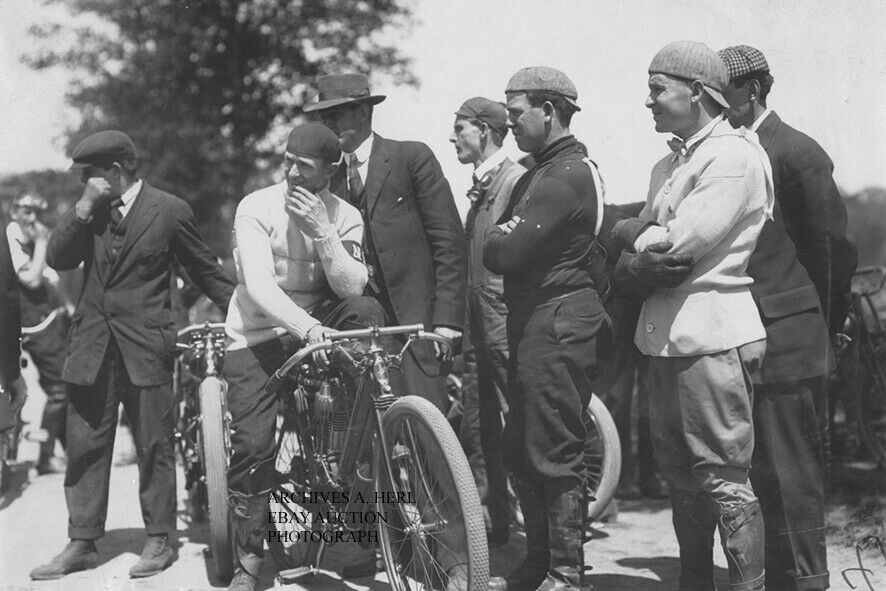-40%
Henderson Motorcycle factory 1912 RARE photo print early photograph 12
$ 4.62
- Description
- Size Guide
Description
A superb and rare photo aHenderson motorcycle
, photographed in 1912!
In 1911 the American
Henderson
Motorcycle Co.,
268 Jefferson Ave.
,
Detroit
,
Michigan
, was formed by William G. Henderson in partnership with his brother Tom W. Henderson. Bill had the ideas and enthusiasm for motorcycling, and Tom had the better financial acumen. The
Henderson
brothers constructed a single prototype motorcycle during 1911. The prototype had the belt drive typical of the times, but this was changed to chain drive for production models. Henderson Motorcycle promptly announced a new 57 cubic inch (934 cc) IOE four cylinder 7 hp motorcycle, with the engine mounted inline with the frame and chain drive. Production began in 1911, using the in-line four cylinder engine and long wheelbase that would become
Henderson
trademarks, and it was available to the public in January 1912. Advertisements boasted 7 H.P. and a price of 5. It was the third, four cylinder, production motorcycle built in the USA., and featured a folding hand-crank starter handle. Improvements included a better brake (singular), lower seating position, and improved girder forks. It was in this year that Carl Stearns Clancy of
New York
returned from circling the globe on a 1912
Henderson
, armed with many photographs to prove it. The 1914 Model C had a two-speed gearbox incorporated in the rear hub. (The first Henderson to have gears.) Shortly after the Model D was announced, it was followed by a Model E, with the wheelbase reduced from 65” to 58”, through a change in the footboards, and this improved handling. The 1916 Henderson Model F featured a shorter wheelbase that became the standard, and the engine now incorporated a cam gear driven “mechanical oiler”, and a kick-start. With the 1917 Hendersons the old splash lubrication was superseded by wet sump lubrication. A three-speed gearbox was now attached to the engine and incorporated a heavy-duty clutch. Sales soared and new dealerships were established. Alan Bedell averaged 48 mph for 1154 miles at Ascot Park in California setting a new 24 hour record, and then, on June 13, 1917, broke the transcontinental long distance record of 1915 (set by “Cannonball” Baker on an Indian Twin,) when he rode his 1917 Henderson from Los Angeles to the city of New York (3,296 miles) in seven days, sixteen hours, and fifteen minutes. The roads outside of towns were primitive by today’s standards, and the ride would have been more like an off road ride than the highway tour of today. The Cannonball Baker Sea-To-Shining-Sea Memorial Trophy Dash was named in Baker's honor. Despite record breaking and racing successes, the effects of WW1 on sales had damaged their financial position. In 1917 the Hendersons sold the firm to Ignaz Schwinn, owner of Schwinn, the manufacturer of Schwinn bicycles and Excelsior motorbikes. Production was moved to Schwinn's Excelsior Motor Mfg.& Supply Co., 3701 Cortland Street, Chicago, Illinois. Hendersons were marketed extensively overseas as well as in the United States during the Schwinn years. Today, there are almost as many extant Hendersons in Europe and Australia/New Zealand as in the U.S. The Excelsior name had already been used in Germany and Britain, so export models were marketed as the "American-X". When production resumed for the new Model H, the engine serial numbers began with a Z, instead of the older H. The Henderson had the following specifications. The engine was an inline four with IOE valve layout. Its displacement: 67 cubic inches (1100 cc), bore x stroke: 2.53 x 3.0 inches (64.3x77.7 mm). The carburetor was a Schebler and ignition was by magneto. A 3-speed transmission was fitted. Only the rear featured a brake, by band. Tire size was 3.00x28 inches (7.62x71 cm) (front and rear). Initially Bill and Tom Henderson worked in management at Excelsior (with Tom receiving twice the pay of Bill), but Tom soon left, early in 1919, to become a Henderson exporter. The 1919 Model Z included a GE generator on the Z-2 “electric” model. The 70 cubic inch (1147 cc) 4-cylinder developed 14.2 H.P. This model had a new Henderson logo which included the red Excelsior “X”. In 1915 Arthur O. Lemon had joined Henderson as a salesman, and was employed in the Excelsior Engineering Department after the sale of Henderson. Lemon designed an updated motor for the 1920 Model K. Bill Henderson and Arthur Lemon had worked closely together in the past, but Bill didn’t like Lemon’s changes toward heavier motorcycles. He left in 1920, before the Model K came into production, to form the Ace Motor Corporation, where he would make the lighter, faster motorcycles he had envisioned. Arthur Lemon was then put in charge of engineering for Excelsior and Henderson. The Model K weighed more, produced more power, and was more durable and reliable than its predecessors. The 79.4 cubic inch (1301 cc) side valve engine, with 2.6875 inch (68.3 mm) bore, and 3.5 inch (88.9 mm) stroke, was rated at 18 hp (28 bhp) The K had a top speed of 80 mph (128 km/h). The Henderson Model K was the first motorcycle to use full pressure engine lubrication. It was also the first motorcycle to offer, an optional, reverse gear (for use with sidecars). The frame had steel forgings on every joint. Forks and handlebars were the same as the Series 20 Excelsior. Among its several advanced features were electric lighting and a fully-enclosed chain. The K continued on sale to 1922, with sales increasing despite the post WW1 depression. Increasingly, Henderson motorcycles were being used by law enforcement agencies, and their reputation continued to improve, with durability and distance records often falling to them. In 1922 the 28 hp (at 3400 rpm) DeLuxe was released. Improvements included a larger, more efficient carburetor, improved intake manifold and rear brakes; redesigned crankshaft, cylinder head cooling, exhaust system and seat. There were also optional Lynite die-cast alloy pistons and a revised reverse gear. The heavier Police Department version was demonstrated first to the Chicago Police, and achieved 98 mph. When it was demonstrated to the San Diego Police a genuine 100 mph was achieved. Harley Davidson, decided to challenge Henderson to a contest that was held at Dundee Road, Chicago, in April 1922. The Harley won the first heat, but lost the other eleven, with the Henderson exceeding 100 mph. This was a shining hour for Henderson. Between May 30 and 31, 1922 Wells Bennet and his Henderson Deluxe set a new 24 hour endurance record (including all the intermediate records) at the Tacoma Speedway, Washington, clocking up 1562.54 miles averaging 65.1 mph. This record was not beaten until 1933, by a Peugeot with a team of four. The solo record was not bettered until 1937 when Fred Ham’s 61 cubic inch Harley averaged 76 mph. On December 11, 1922 William Henderson was killed in a motor accident testing his new Ace. In 1923 Arthur O. Lemon left Excelsior to become chief engineer for Ace. The 1926 Henderson had its frame redesigned with a downward slope to the rear for a lower centre of gravity. This enabled the fitting of a shorter, wider, 4 US gallon (15 litre) fuel tank. Three ring alloy pistons were now standard, the cylinders and camshaft were changed, low and reverse gear ratios were altered and it was fitted with larger 3.85” tyres. The 1927 Henderson DeLuxe featured machined and polished “Ricardo” cylinder-heads and developed 35 hp at 3,800 rpm. The clutch was strengthened with two extra plates. There was a new tank top instrument cluster, featuring speedometer, ammeter, oil pressure gauge and a headlight switch. There were new valve spring covers and an updated Zenith carburetor. On January 27, 1927 the Indian Motorcycle Company purchased the Ace Motor Corporation. Arthur Lemon moved to Indian, where the Ace was to become the Indian Four. The 1928 Henderson DeLuxe engine had higher compression, and hardened, polished steel valve guides. The front end was changed to leading link forks and a front brake was added. The wheels were also changed to drop center rims (may have happened mid year). In June 1928, Schwinn poached Arthur Constantine from Harley-Davidson, to become Chief Engineer. Constantine looked at the existing model, and embarked on a redesign. The Henderson Streamline model, commonly called the "KJ", appeared in 1929, and featured improved cooling and a return to the IOE (inlet over exhaust) valve configuration, gave 40 bhp at 4000 rpm. It had a five main bearing crankshaft, and down draft carburetion. Advertisements boasted of “57 New Features”. The Streamline was fast - capable of a genuine 100 mph (160 km/h), and advanced for its time, with such features as leading-link forks and an illuminated speedometer built into the fuel tank. The Streamline model was produced from 1929 until 1931, and sold for 5. On Black
Tuesday, October 29, 1929
, the Wall Street stock market crashed, but
Henderson
sales remained strong, and business continued. At this point Excelsior Motor Mfg. & Supply Co. was one of
America
’s “Big Three” of motorcycle production, alongside Harley Davidson and Indian. On
April 29, 1930
, the new
Henderson
“Special” KL solo was demonstrated on a new smooth concrete
Illinois
highway. Joe Petrali achieved 116.12 mph and 109.09 mph on two recorded runs, averaging 112.61. The higher compression two-ring pistons, and an enlarged 1.25 inch (32 mm) carburetor, meant the KL engine produced 45 hp at 4,500 rpm. The KL was remarkably flexible in top gear, pulling smoothly from 8 to 110 mph. They were even more popular with U.S. Police Departments. The "Special" (KL) model was priced more than the regular KJ model, and was available in 1930 and 1931. The summer of 1931 saw Schwinn call his department heads together for a meeting at Excelsior. He bluntly told them, with no prior indication, “Gentlemen, today we stop”. Schwinn felt that the Depression could easily continue for eight years, and even worsen. Despite of the full order book, he had chosen to pare back his business commitments to the core business, bicycle manufacture. By September 1931 it was all over. In 1994, founded by Dan and Dave Hanlon secured the rights to the defunct Excelsior-Henderson trademark and founded the Excelsior-Henderson Motorcycle Company in Belle Plaine, Minnesota. The company declared bankruptcy in 1999 and folded soon after.
This is a very nice and very rare
non period
photo that reflects a wonderful era of Henderson ‘s motorcycle history in a wonderful way. This is your rare chance to own this photo, therefore it is printed in a nice large format of ca. 8" x 12" (ca. 20 x 30 cm). It makes it perfectly suitable for framing!
Shipping costs will only be $ 7.00 regardless of how many photos you buy. For 5 or more photos, shipping is free!
(Note: A. Herl, Inc. does not appear on photo, for ebay purposes only)
No copyright expressed or implied. Sold as collectable item only. We are clearing out our archives that we have gathered from various sources.
All items always sent well protected in PVC clear files
and board backed envelopes.
We have photographs that came from professional collections and/or were bought from the original photographer or press studio! They are all of professional and excellent quality.
After many decades of professionally collecting photographs and posters we are clearing out our archives. They make the perfect gift and are perfectly suited for framing. They will look gorgeous unframed and will be a true asset nicely framed with a border. They are a gorgeous and great asset in every home, workshop, workplace, restaurant, bar or club!
First come - first served. And you can always contact us for your requests. Please ask any questions before the auction ends.









